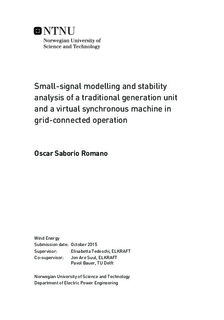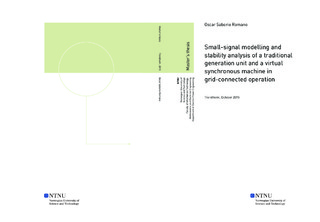| dc.description.abstract | In this work, previous small-signal modelling and analysis carried out for a VSM implementation has been adapted and expanded to include a synchronous machine (SM) with a control scheme similar to those of traditional generation units and to the one used in the VSM implementation.
A non-linear state-space analytical model has been developed for a traditional power generation unit in grid-connected mode (SM system). The model allows the study of the SM system in similar conditions/context as the grid-connected VSM implementation (VSM system), and facilitates their comparison. Moreover, it can represent the most relevant dynamic characteristics of a round or salient-pole rotor SM, including the amortisseur circuits or the representation of the corresponding damping torque in the swing equation of a reduced-order version of the model. The developed model has been linearised analytically, to obtain the respective small-signal model.
The eigenvalue analysis of the modelled systems has indicated that most of the SM system eigenvalues (modes) are slower or not as well damped as the VSM system ones. Moreover, most SM system modes have shown to be relatively fixed and determined mainly by non-tunable parameters. The modelled exciter has presented little capability of increasing the damping of oscillations, and its integral gain has demonstrated to be the tunable parameter that can most easily cause instability in the SM system. The location of the 4 slowest and least damped SM system eigenvalues has shown to be limited by non-tunable parameters, indicating that the performance or robustness of such system cannot be significantly improved. A trade-off has been observed in the placement of the VSM system critical modes: increasing the virtual impedance improves the damping of oscillations, while making the system response slower. However, parametric sweep analysis has indicated that a good compromise between performance and robustness could be achieved by decreasing the virtual impedance and increasing the phase lock loop proportional gain. | |

